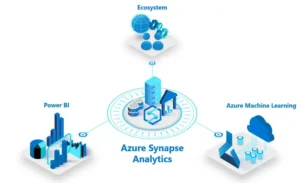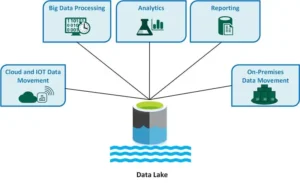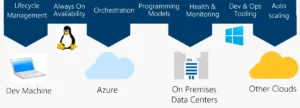Data warehousing plays a pivotal role in consolidating data from various sources to enable effective decision-making and insightful analysis. Microsoft’s ecosystem offers a plethora of services and technologies designed to streamline this process. This article delves into the core offerings like Azure Synapse Analytics, providing readers with a thorough understanding of data warehousing capabilities within Microsoft’s framework.
Index
- What is Data Warehousing?
- Azure Synapse Analytics: Microsoft’s Premier Data Warehousing Solution
- Integrating Data Lakes for Enhanced Warehousing
- Data Orchestration with Azure Data Factory
- On-premises Solutions: SQL Server Analysis Services
- The Role of Service Fabric in Microsoft’s Data Ecosystem
- References

1. What is Data Warehousing?
Data warehousing is a vital strategy in data management, designed to support the decision-making process within organizations. It entails the systematic approach of collecting, cleansing, and consolidating data from disparate sources into a centralized repository, known as a data warehouse. This process involves several key steps:
- Collection: Data is aggregated from multiple sources, which may include operational databases, external data feeds, and historical archives. This stage is crucial for gathering the raw data needed for analysis.
- Cleansing: The collected data is then cleaned to ensure accuracy and consistency. This step involves removing duplicates, correcting errors, and standardizing data formats, which is essential for reliable analysis.
- Consolidation: After cleansing, data is consolidated into a unified format in the data warehouse. This involves organizing the data into schemas that are optimized for query and analysis, rather than transaction processing.
The primary goal of data warehousing is to create a reliable, centralized source of data for analysis and reporting. By doing so, organizations can perform complex queries and analyses across vast datasets, uncovering patterns and insights that would be difficult to discern from disparate sources. This capability supports strategic decision-making by providing a comprehensive view of the organization’s data landscape.
Furthermore, data warehousing enables the historical data storage, allowing analysts to track trends over time and predict future patterns. This aspect is particularly valuable for businesses looking to understand their growth, forecast demands, or identify potential areas for improvement.
2. Azure Synapse Analytics: Microsoft’s Premier Data Warehousing Solution
Azure Synapse Analytics stands at the forefront of Microsoft’s offerings in data warehousing and analytics. This service is designed to bridge the gap between big data and traditional data warehousing, providing a powerful platform for data exploration, analysis, and reporting.

Key features of Azure Synapse Analytics include:
- On-demand and provisioned query processing: Azure Synapse allows users to perform data queries using either on-demand resources for flexible, pay-as-you-go analysis or provisioned resources for dedicated performance. This flexibility ensures that organizations can scale their data processing capabilities according to their needs.
- Integration with big data and data lakes: Azure Synapse is deeply integrated with other Azure services, such as Azure Data Lake Storage, enabling seamless access to big data for comprehensive analytics. This integration allows for the ingestion of structured and unstructured data, broadening the scope of analysis.
- Data management and orchestration: With Azure Synapse, organizations can not only query and analyze their data but also manage and orchestrate data workflows. The service includes tools for data ingestion, preparation, and transformation, facilitating a streamlined process from raw data to actionable insights.
- Unified analytics platform: Azure Synapse provides a unified experience for data analytics, combining data warehousing, big data analytics, and data integration capabilities. This convergence enables analysts and data scientists to collaborate more effectively, sharing insights and leveraging a common platform for all their data workloads.
- Security and compliance: Azure Synapse is built with industry-leading security measures, including data encryption, private link networking, and compliance certifications. These features ensure that data is securely managed and processed in accordance with regulatory standards.
By leveraging Azure Synapse Analytics, enterprises can harness the power of their data more effectively, turning vast datasets into actionable insights. This service not only supports the technical aspects of data warehousing and analytics but also empowers organizations to innovate and make informed decisions based on comprehensive data analysis.
3. Integrating Data Lakes for Enhanced Warehousing
Data lakes have become an indispensable element in the data management and warehousing ecosystem, particularly with the advent of cloud computing and services like Azure Data Lake. They offer a scalable and cost-effective solution for storing massive volumes of data, both structured and unstructured, which is crucial for organizations dealing with big data. The concept of data lakes complements traditional data warehousing by providing a more agile and flexible environment for data analysis.
Flexibility and Scalability
One of the key advantages of data lakes is their schema-on-read architecture, as opposed to the schema-on-write approach used in traditional data warehouses. This means that data can be stored in its native format without a predefined schema, allowing for greater flexibility in data processing and analysis. Analysts can define the structure of the data at the time of reading, tailoring it to the specific requirements of each analysis task.
Integration with Azure Synapse Analytics
The integration of data lakes with Azure Synapse Analytics significantly enhances data warehousing capabilities. This combination allows businesses to perform advanced analytics on large, diverse datasets that combine both structured data from traditional databases and unstructured data, such as logs, IoT data, and social media content. By leveraging data lakes, organizations can utilize Azure Synapse’s powerful analytical tools to gain deeper insights and drive more informed decision-making.

Comprehensive Data Analysis
The integration also facilitates complex analytical operations, such as machine learning and predictive analytics, directly on the data stored in data lakes. This ability to analyze data in its native format without extensive preprocessing or transformation opens up new possibilities for uncovering valuable insights, enabling more dynamic and responsive analytical processes.
Enhanced Data Management
Integrating data lakes with data warehousing solutions streamlines data management practices. Data can be ingested into a data lake from a wide array of sources, stored cost-effectively, and then selectively moved into a data warehouse for more structured analysis and reporting. This layered approach to data management allows organizations to balance the agility and depth of analysis provided by data lakes with the performance and structure of traditional data warehousing.
4. Data Orchestration with Azure Data Factory
Azure Data Factory (ADF) plays a pivotal role in modern data warehousing strategies by providing sophisticated data orchestration and integration services. As Microsoft’s cloud-based data integration service, ADF enables the creation, scheduling, and orchestration of data-driven workflows, facilitating the automated movement and transformation of data across various storage and processing services.

ETL and Data Integration
ADF excels in supporting the ETL (extract, transform, load) process, which is fundamental to data warehousing. It allows for the efficient extraction of data from diverse sources, its transformation into a format suitable for analysis, and the loading of this processed data into a data warehouse or data lake. ADF’s visual tools and integration capabilities make it accessible for users to design and manage complex data pipelines without extensive coding.
Seamless Integration with Azure Services
ADF is deeply integrated with other Azure services, including Azure Synapse Analytics, Azure Data Lake, and Azure SQL Data Warehouse. This integration ensures a seamless data flow between services, enabling a more cohesive and efficient data management ecosystem. For instance, data ingested into Azure Data Lake can be easily processed and transformed using ADF and then moved into Azure Synapse Analytics for detailed analysis.
Automating Data Workflows
The ability to automate data workflows with ADF significantly enhances operational efficiency. Scheduled data pipelines can automate the ingestion, processing, and movement of data, ensuring that data warehouses and lakes are regularly updated with fresh data. This automation supports real-time analytics and decision-making by providing timely and accurate data.
Advanced Capabilities
ADF also includes features such as data monitoring, lineage, and management, providing visibility into data flows and processing. Its support for a wide range of data sources and destinations, from on-premises databases to cloud-based services, along with its scalability and flexibility, makes ADF an essential tool for organizations looking to optimize their data orchestration practices.
Integrating data lakes for enhanced warehousing and leveraging data orchestration with Azure Data Factory are critical components of a comprehensive data management strategy. These technologies not only provide the infrastructure for storing and processing vast amounts of data but also empower organizations to derive actionable insights through advanced analytics and machine learning.
5. On-premises Solutions: SQL Server Analysis Services
SQL Server Analysis Services (SSAS) is a critical component for organizations leveraging on-premises data warehousing solutions. SSAS is a technology developed by Microsoft to deliver online analytical processing (OLAP) and data mining capabilities. This enables businesses to analyze data in a multidimensional space, enhancing their ability to make informed decisions based on comprehensive data analysis. Here are some key features and benefits of SSAS:
- OLAP Cubes: SSAS allows the creation of OLAP cubes, which are data structures that pre-aggregate data to speed up query times. These cubes enable users to explore data across multiple dimensions, making it easier to uncover trends and patterns that may not be visible in flat, relational data structures.
- Data Mining Models: Beyond OLAP, SSAS provides data mining capabilities, allowing businesses to forecast trends and make predictions based on historical data. This is particularly useful for scenarios such as customer segmentation, sales forecasting, and fraud detection.
- Efficient Data Analysis: By pre-calculating and storing complex queries, SSAS improves the performance of data retrieval operations. This means that businesses can run complex analytical queries more efficiently, enabling faster insights into their data.
- Integration with Existing Infrastructure: For businesses with significant investments in on-premises infrastructure, SSAS integrates seamlessly with SQL Server and other Microsoft technologies. This allows organizations to enhance their existing data warehousing solutions without the need for substantial architectural changes.
- Advanced Security Features: SSAS includes robust security mechanisms, such as role-based access control, which ensures that sensitive data is protected and only accessible to authorized users.
SSAS offers a powerful toolset for businesses not fully transitioned to the cloud or those with specific regulatory or operational requirements for on-premises data management. By leveraging SSAS, organizations can take advantage of advanced data analysis and reporting capabilities, enhancing their ability to derive insights from their business data.
6. The Role of Service Fabric in Microsoft’s Data Ecosystem
Azure Service Fabric represents a critical piece of the puzzle in the Microsoft data ecosystem, especially as organizations increasingly adopt microservices architectures. While it is not directly a data warehousing tool, its importance in supporting the infrastructure for data-intensive applications cannot be overstated.

Here are several ways Service Fabric contributes to data warehousing and analytics:
- Microservices Architecture: Service Fabric is designed to support the development, deployment, and management of microservices. This architecture is particularly well-suited for modern data applications that require scalability, resilience, and flexibility. By breaking down applications into smaller, decoupled services, businesses can more easily manage and scale their data processing and analytics workloads.
- High Availability and Scalability: Service Fabric ensures that applications are highly available and scalable, which is essential for critical data warehousing operations. It automatically manages the placement and redundancy of microservices, ensuring that data processing services remain available even in the face of hardware or software failures.
- Container Management: With the increasing use of containers in deploying applications, Service Fabric provides robust container orchestration capabilities. This allows businesses to package their data processing and analytics services into containers, simplifying deployment and management across diverse environments.
- Stateful Services: Unlike many other microservices platforms, Service Fabric supports stateful services, enabling applications to maintain a local state across sessions. This capability is particularly useful for complex data processing scenarios, where maintaining state can significantly enhance performance and simplify application logic.
- Integration with Data Services: Service Fabric seamlessly integrates with other Microsoft data services, including Azure Synapse Analytics, Azure Data Lake, and SQL Server. This integration enables a cohesive and efficient environment for processing and analyzing data at scale.
Service Fabric’s contribution to the Microsoft data ecosystem is primarily in its ability to support the infrastructure requirements of modern, data-intensive applications. Its capabilities in managing microservices and container-based applications ensure that businesses can develop, deploy, and scale their data processing and analytics workloads with confidence, making it an indispensable tool in the broader context of data warehousing and analytics strategies.
7. References
- Azure Synapse Analytics Documentation: Provides comprehensive guides and tutorials on utilizing Azure Synapse for data warehousing and analytics.
- Azure Data Lake Storage Documentation: Offers detailed information on implementing and managing Azure Data Lake as part of a data warehousing solution.
- Azure Data Factory Documentation: Includes resources for creating data-driven workflows for automating data movements and transformations.
- SQL Server Analysis Services (SSAS) Documentation: Contains in-depth knowledge on deploying and using SSAS for on-premises data analysis.
- Azure Service Fabric Documentation: Provides resources on developing and managing applications using Service Fabric, supporting the infrastructure for data services.
